Current as of: December 24, 2025 - 14:27

Bosnia & Beyond Trip Notes
- Ways to Travel: Guided Group
- Destination: Bosnia & Herzegovina, Croatia, Montenegro
- Programmes: Culture
-
Activity Level:
3 out of 7 - Moderate
- 11 Days: Land Only
- Ages: 16+
- Trip Code: AVB
- Carbon Footprint: 18kg CO2e
Trip Overview
Experience the cultural variety and rugged natural beauty of Bosnia & Herzegovina and Montenegro
Bosnia and Herzegovina and Montenegro have been at the crossroads of ancient civilisations for centuries, with a magical mixture of European and Near Eastern culture. The diversity is very clear, from the vibrant cities to the tiny traditional villages. Here we find a unique fusion of traditions, religions and architecture. Outside the towns and cities, the raw natural beauty is breath-taking, with ancient forests, rugged peaks and the beautiful Adriatic coastline where we explore the magnificent Bay of Kotor before making our final stop in the wonderful Croatian city of Dubrovnik.
At a Glance
- Accommodation: 10 Classic nights (hotels)
- Group normally 6 to 18, plus leader. Minimum age: 16
Highlights
- Discover a mix of Balkan countries with beautiful scenery and fascinating cultures
- Explore Sarajevo, the cosmopolitan and historic capital of Bosnia
- Visit enchanting Mostar with its iconic bridge
- Admire the beauty of the sparkling Adriatic in Kotor, Montenegro
- Walk the pristine marble streets of Dubrovnik
- Enjoy gentle walking in Durmitor National Park
Is This Trip for You?
This trip is rated Activity Level 3 (Moderate). For more on our trip gradings, visit our Activity Level Guidelines page.
Suitability: This is a cultural discovery trip with some walking. You don’t need to be an experienced hill walker, just have a good level of fitness. Walks are optional so the trip is suitable for anyone. Travel is by private bus, generally on good roads.
Water safety: This trip includes time by a lake, river or sea, where there may be opportunities to swim. You should always seek local advice before deciding whether to swim. Open-water or wild swim spots should be treated with extreme caution. Information on how to keep yourself safe while swimming is shown here.
Adult min age: 16
Min group size: 6
Max group size: 18
Itinerary
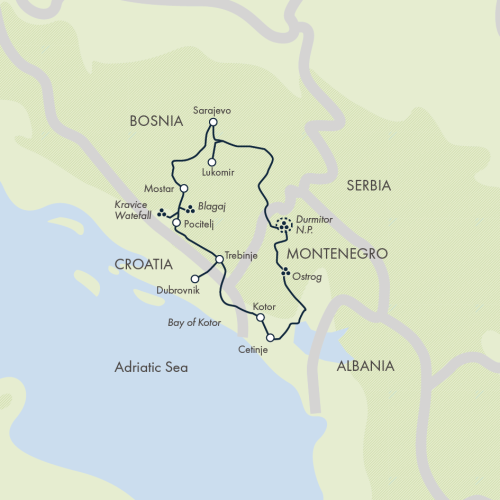
Land Only
- Start City: Dubrovnik
- End City: Dubrovnik
Land Only Itinerary
The adventure begins at Dubrovnik Airport in Croatia, where we meet as a group to catch our transfer (one hour) to Trebinje in Bosnia and Herzegovina, one of the most beautiful small cities in the country.
The old town, which is a short walk from our hotel, is the perfect introduction to Herzegovina’s cultural heritage with stone architecture, shaded squares, and the 18th-century Arslanagić Bridge.
Around 6pm, we gather as a group to learn more about the adventures ahead. Your tour leader ensures a big welcome by arranging a group dinner by the banks of the Trebišnjica River.
Want more time in Trebinje or Dubrovnik? Secure pre-tour hotel nights through your sales representative.
Accommodation: Hotel Leotar/Hotel Central Park (or similar)
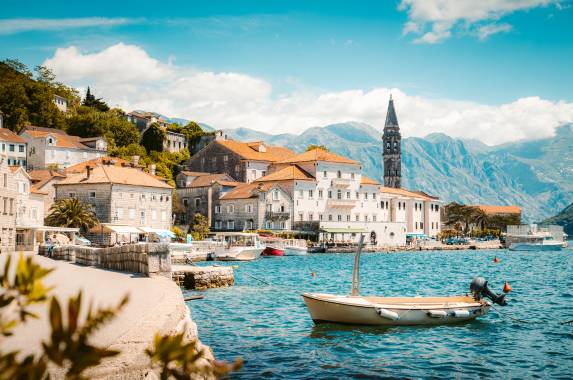
Bid farewell to Trebinje this morning and transfer (approximately two hours) to the coastal town of Kotor in Montenegro. We set out to discover the Old Town, a World Heritage site since 1979.
On our guided walk (approximately two hours), we wander through atmospheric streets and squares, lined with elegant townhouses (known locally as palaces) and an array of impressive churches and monuments that reflect centuries of Venetian and Byzantine influence.
After, we transfer (25 minutes) to Perast, a town once owned by the Venetians, which explains the Italian feel. It is dominated by the 17th-century church of St Nikola, protected by a Venetian fortress and surrounded by beautiful palaces and gardens built by once-famous sea captains of the Adriatic.
Here, we have lunch overlooking the bay, before a boat ride to the Lady of the Rocks island and a visit to the chapel. The views of the Dinaric Alps from the boat are impressive, giving us a different perspective of the Montenegrin coastline.
We transfer back to our hotel by boat, the best way to enjoy this fabulous setting.
Accommodation: Hotel Splendido/Hotel Porto In (or similar)
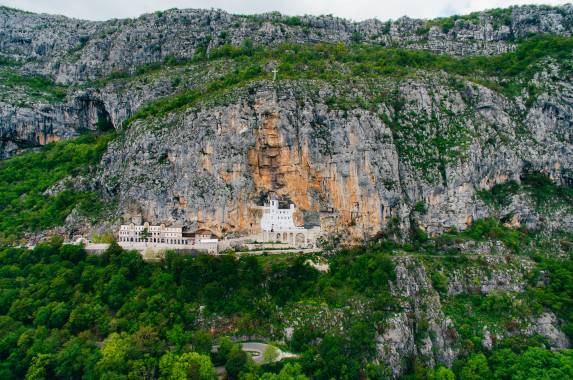
We transfer (approximately two hours) to Cetinje for a tour. The town lies at the foot of the Lovcen Mountain and was the ancient capital of Montenegro. Since 1485, it has been the sacred centre of Montenegro; as a result, the city houses more museums and cultural heritage sites than any other in the country. Our tour takes us to some of the main sites in this cultural oasis in the Cetinjsko fields.
From Cetinje, we set off towards the mountainous interior of Montenegro, visiting the holy shrine of St Vasilije high in the shady Ostrog Mountains en route. Few people expect to witness such a marvellous spectacle when they arrive. Intricately carved into the rising rock face, the Ostrog Monastery is considered by many to be the most inspiring Orthodox sacred place in the former Yugoslavia. It has become the largest religious pilgrimage site in the country, with many Orthodox Christians and even Catholics and Muslims paying homage to St Vasilije, the founder of the 17th-century monastery. The day culminates with a drive (approximately three hours) through isolated villages and high mountain passes to the small ski resort of Zabljak, which sits neatly on a plateau at 4,920ft (1,500m), surrounded by beautiful pinewood forests, high alpine mountains and the deep Tara Canyon.
Accommodation: Hotel Zabljak (or similar)
Today we explore the Zabljak Plateau with its numerous lakes and traditional villages. We start with a walk around the largest lake in the area, where the waters reflect the surrounding peaks. Around lunchtime, we transfer to the village of Podgora, which has recently become part of a regional ecovillage network helping to promote tourism in rural communities. A local family provides us with a tasty lunch of traditional Montenegrin mountain food. We also visit and enjoy views from one of the numerous viewpoints above the Unesco-listed Tara Canyon, said to be the deepest canyon in Europe.
We then transfer back to Zabljak and have the afternoon free to explore, enjoy a scenic walk, go for an invigorating dip in the lake, or perhaps drink a glass of local wine or beer in a cafe.
Accommodation: Hotel Zabljak (or similar)
We transfer (approximately two to three hours) to the Montenegro-Bosnia border, via Durmitor’s interior with its impressive peaks, isolated mountain lakes and deep canyons. The mountain roads are narrow and we meet the occasional shepherd with his sheep moving up to the higher grassy pastures of Durmitor. This seasonal migration has taken place for centuries and is very much part of Montenegrin culture, even today.
We drive to Brod na Drini, where we stop for lunch at a restaurant with views overlooking the Drina River. After lunch, we continue our journey through the remote and mountainous eastern region of Bosnia and Herzegovina, making our way to Sarajevo.
Accommodation: Hotel Diamond Rain (or similar)
Today we have a full day exploring Sarajevo on foot and by bus. One of the most culturally diverse cities in Europe, Sarajevo spent more than 400 years under Turkish governorship until the Austro-Hungarians arrived in the late 19th century. Forty years later, the empire collapsed when Archduke Ferdinand was assassinated here, hastening the outbreak of the First World War. The late-20th century saw Sarajevo host the 1984 Winter Olympics, and the long siege of the city during the recent conflict. Our tour of the major historical, cultural and war sites in the city will help you piece together its complex history.
Our day involves a walking tour of the main sites and a visit to the Sarajevo Tunnel Museum. The tunnel provided the Sarajevo citizens a lifeline during Sarajevo’s 1,400 days of isolation and was the only reliable way of supplying goods and electricity to the city as all other supply lines were cut off by the Serbian Army. This is a sobering and fascinating visit.
Accommodation: Hotel Diamond Rain (or similar)
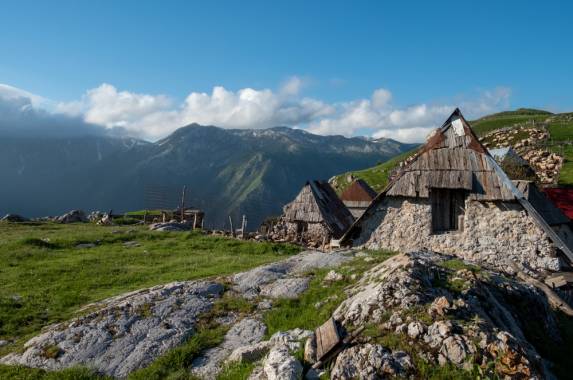
We transfer (approximately two hours) to Lukomir, the highest village in Bosnia at 4,820ft (1,469m), with its ancient stecci (medieval tombstones). Here, we get an insight into the traditional way of life. Customary dress and the occasional turban and fez are still worn, going hand in hand with the more contemporary features of everyday life. The village houses here are a powerful image of a simpler time. We then take a walk down towards the Rakitnica Canyon nearby and find excellent viewpoints to admire this majestic scenery. The scale of the mountains coupled with the canyon far below are sights that will live long in the memory. Lunch is taken in the village, prepared by one of the main families still living there. It’s a traditional, filling meal and the family normally sits down − an excellent chance to learn firsthand about daily life in the mountains. We return to Sarajevo at the end of the day.
Accommodation: Hotel Diamond Rain (or similar)
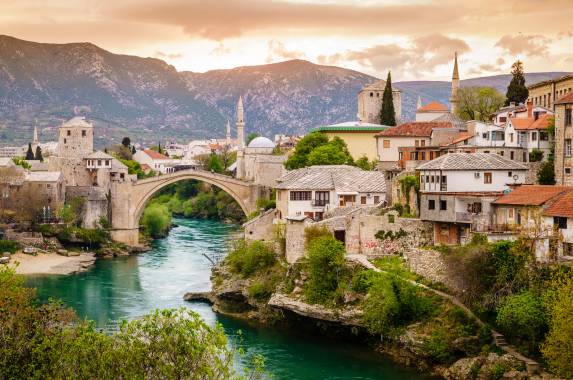
We transfer (approximately 2hr 30min) to Mostar where we have a whole day to visit this beautiful Herzegovinian city. Mostar was founded in the 15th century and the architecture is a precious combination of Turkish ingenuity and Herzegovinian and Dalmatian workmanship. We spend the morning and afternoon exploring Mostar, a city split during the conflict of the early 1990s. We see the scars of war, but these days Mostar is once again a warm and bustling place with an intriguing history. The rest of the day is free for you to explore the city on your own.
Accommodation: Hotel Kapetanovina/Hotel Almira (or similar)
Our first stop today will be Pocitelj, another Unesco World Heritage site and host to the longest-operating art colony in southeast Europe. The most striking object in Pocitelj is the Kula, a silo-shaped fort that dominates the skyline from a hill above the town. It once housed watchmen and military guarding against possible invasion from the Neretva Valley. Our next stop is Kravica Waterfall, a green oasis in the rocky Herzegovinian landscape. After a short walk, and perhaps a cooling swim, we head to Blagaj for lunch.
The Blagaj highlights are the Buna Spring and the adjacent Ottoman house/monastery. The spring here is amazing. It flows out of a 655ft (200m) cliff wall to form the Buna River. Unsurprisingly, the Ottoman sultan was impressed and ordered a tekija to be built right next to it. This 16th-century house/monastery was built for the Dervish cults and is still one of the most mystical places in all Bosnia and Herzegovina. Also in the vicinity are old flour mills that the strong Buna River used to power. We spend the late afternoon and evening in Mostar.
Accommodation: Hotel Kapetanovina/Hotel Almira (or similar)
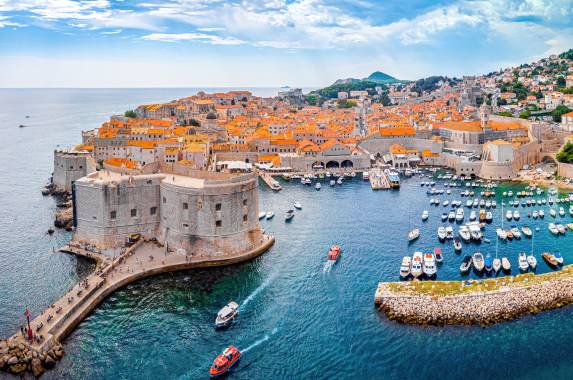
Our journey now takes us back to Dubrovnik via Radimlja with its numerous beautiful medieval Christian tombstones, and Trebinje, the southernmost city in Bosnia and Herzegovina. Trebinje has a rich history dating to the Middle Ages. Here we visit a family-owned winery and get a taste of life in old Herzegovina, venturing into the cellars to sample the rich, earthy, bold tastes of the red wines.
The wines of Herzegovina are among the newest in the second world wine category. This tradition, however, has been in existence since Roman times. The sunny Mediterranean climate and rich hinterland soils here produce some of the finest wines in southern Europe.
Then, we travel south to our final destination: Dubrovnik, a magnificent walled city at the southernmost tip of Croatia. Formerly a prosperous trading centre, Dubrovnik is now a Unesco World Heritage site, and the perfectly preserved Old Town and rich cultural life draw many visitors each year. We end the day with free time, so you can swim in the warm Adriatic or explore the Old Town solo and take a walk along the ancient city walls.
Accommodation: Hotel Komodor/Hotel Adria (or similar)
The trip ends this morning in Dubrovnik after breakfast. You may wish to extend your stay in the Croatian capital to further explore its cobbled streets or enjoy the beautiful coastline. Should you wish to do so, please ask your sales representative about our post-tour nights.
Accommodation
Well-located hotels
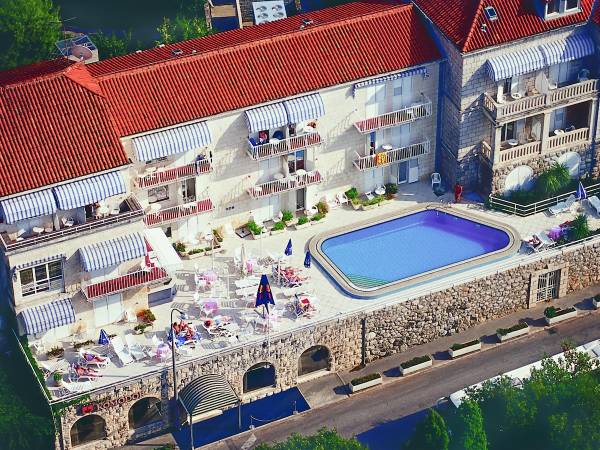
We spend 10 nights in hotels, most of which are well located for our adventures. The accommodations typically used are listed in the day-to-day itinerary.
Worth knowing
- Tourism is still developing in the Balkans – one of the reasons it’s ideal for adventurous travellers. We have seen increased investment in infrastructure over the years, but there is a difference in quality between some of the city hotels and the more rustic hotels and pensions in the smaller towns.
Single supplement from £ 670
Food & Drink
Breakfast will usually be either hot and cold buffets or a choice of set meals. Breakfast in Bosnia and across the Balkans usually consists of bread and pastries, dairy products such as yoghurt and cheese, cereal, eggs cooked in a variety of ways, smoked meats, honey, tea and coffee, milk and juices.
Typical Bosnian cuisine consists of ingredients such as tomatoes, potatoes, onions, garlic, peppers, cucumbers, mushrooms, spinach, beans and dairy products such as milk, cheese, pavlaka (sour cream) and kajmak (similar to clotted cream). Meat dishes usually consist of beef and lamb and specialities include cevapi, burek, dolma (stuffed vegetables with meat) and goulash. Desserts often have an Eastern influence with baklava being very popular. The alcoholic drink rakija, made from apples or plums, is common in this region also.
Vegetarian and special diets can be catered for, but options are limited throughout Bosnia and Herzegovina and Montenegro. Please advise of any specific dietary requirements at time of booking.
Transport
We travel by private minibus. The main roads are generally good, but mountain roads can be winding and you may at times experience a slow and bumpy ride.
Weather & Seasonality
Bosnia and Herzegovina and Montenegro enjoy a similar climate to most of Central Europe: hot summers, cool springs and autumns, and cold winters with considerable snowfall. We visit from July to August, when temperatures will be generally warm (25C-30C/77F-86F). However, it will be a little cooler in the mountains. It is here we are right in the middle of the Central Dinaric Alps, a rough and unpredictable place where Mediterranean and Continental Alpine climates vie for supremacy. The result is an extremely unstable climate even in summer. Rain can fall at any time of the year, although in mid-summer it is more likely to come as short, sharp thunderstorms.
Joining Instructions
Key information
Start hotel: Hotel Leotar/Hotel Central Park
Airport: Dubrovnik Airport (DBV)
Recommended arrival time: Aim to arrive at the start hotel in the afternoon. There is a welcome briefing around 6pm and dinner in the evening.
Getting to the start hotel
The start hotel is approximately one hour from the airport. We provide one group transfer from the airport to the hotel, which you can join at no extra cost, provided you can be at the airport before the transfer leaves. Speak to your sales representative for the transfer times or to arrange a private transfer.
Catching your return flight
There’s one group transfer to the airport, which you can join at no extra cost. Please speak to your sales representative for the time of the transfer. If the group transfer does not suit your flight time, speak to your sales representative to arrange an alternative.
Full joining instructions including local emergency numbers will be sent to you as part of our Final Joining Instructions. If you do not receive these at least a week before departure, or require them earlier please contact our office or your travel agent.
Location start: Dubrovnik
Location end: Dubrovnik
What To Take
Essential Equipment
- Small daypack
- Water bottle
- Waterproof jacket
- Good sturdy shoes or preferably walking boots for the walks
- Warm top or fleece and trousers (pants)
- Shorts
- Towel and swimming costume
- Hat
- Sunscreen
Optional Equipment
- Walking poles
Reading List
Trek through Bosnia’s emerging cultural corridor by Exodus Travels
Practical Information
Visa
Bosnia & Herzegovina
Travellers from the UK, US and EU normally do not need a visa to enter Bosnia and Herzegovina. Please note, visa requirements often change and it is your responsibility to obtain any required visas for this trip. Therefore, we recommend that you check with the nearest embassy or consulate of your chosen destination(s), including any countries you may be transiting or transferring through.
Some local governments provide guidance on what visas their citizens need. To help, we’ve gathered a selection of useful links below.
- Australia: www.smartraveller.gov.au/destinations/europe/bosnia-and-herzegovina
- Canada: www.travel.gc.ca/destinations/bosnia-and-herzegovina
- United Kingdom: www.gov.uk/foreign-travel-advice/bosnia-and-herzegovina/entry-requirements
- USA: www.travel.state.gov/content/travel/en/international-travel/International-Travel-Country-Information-Pages/BosniaandHerzegovina.html
Croatia
Travellers from the UK, US and EU normally do not need a visa to enter Croatia. Please note, visa requirements often change and it is your responsibility to obtain any required visas for this trip. Therefore, we recommend that you check with the nearest embassy or consulate of your chosen destination(s), including any countries you may be transiting or transferring through.
Some local governments provide guidance on what visas their citizens need. To help, we’ve gathered a selection of useful links below.
• Australia: www.smartraveller.gov.au/destinations/europe/croatia
• Canada: www.travel.gc.ca/destinations/croatia
• United Kingdom: www.gov.uk/foreign-travel-advice/croatia/entry-requirements
• USA: www.travel.state.gov/content/travel/en/international-travel/International-Travel-Country-Information-Pages/Croatia.html
Montenegro
Travellers from the UK, US and EU normally do not need a visa to enter Montenegro. Please note, visa requirements often change and it is your responsibility to obtain any required visas for this trip. Therefore, we recommend that you check with the nearest embassy or consulate of your chosen destination(s), including any countries you may be transiting or transferring through.
Some local governments provide guidance on what visas their citizens need. To help, we’ve gathered a selection of useful links below.
- Australia: www.smartraveller.gov.au/destinations/europe/montenegro
- Canada: www.travel.gc.ca/destinations/montenegro
- United Kingdom: www.gov.uk/foreign-travel-advice/montenegro/entry-requirements
- USA: www.travel.state.gov/content/travel/en/international-travel/International-Travel-Country-Information-Pages/Montenegro.html
Vaccinations and Health
Bosnia & Herzegovina
There are no required vaccinations. However, you may want to consider vaccinations for tetanus, hepatitis A, hepatitis B, rabies, tick-borne encephalitis (TBE) and tuberculosis. Please confirm with your doctor or travel clinic.
Croatia
There are no required vaccinations. However, you may want to consider vaccinations for hepatitis A, hepatitis B, tetanus, rabies and tick-borne encephalitis. Please confirm with your doctor or travel clinic.
Montenegro
There are no required vaccinations. However, you may want to consider vaccinations for tetanus, hepatitis A, hepatitis B, rabies and tick-borne encephalitis (TBE). Please confirm with your doctor or travel clinic.
Ticks are known to be present in this region and can carry lyme disease, tick-borne encephalitis and other diseases. Please take care to protect yourself. You can read more about ticks here.
Local Time
Bosnia & Herzegovina's time zone: Europe/Sarajevo (UTC +01:00)
Croatia's time zone: Europe/Zagreb (UTC +01:00)
Montenegro's time zone: Europe/Podgorica (UTC +01:00)
Electricity
Bosnia & Herzegovina's electricity: Plug types C (two round pins) and F (two round pins) – 230V, 50Hz
Croatia's electricity: Plug types C (two round pins, European standard) and F (two round pins) – 230V, 50Hz
Montenegro's electricity: Plug types C (two round pins) and F (two round pins) – 230V, 50Hz

Money
Bosnia & Herzegovina's currency: Convertible mark (BAM)
Croatia's currency: Euros (EUR)
Montenegro's currency: Euro (EUR)
ATM Availability
ATMs and banks are available throughout the trip. You can use credit cards in many shops and restaurants in Montenegro, Bosnia and Herzegovina, and Croatia.
Extra Expenses & Spending Money
We recommend you allow up to €15 for lunch and €20 for dinner in Bosnia and Herzegovina and Montenegro, and €30 for dinner in Dubrovnik. This amount will vary according to where and what you choose to eat. Although not customary in Bosnia, you can leave a 10 percent tip as a sign of your appreciation for the waiter.
The bus into Dubrovnik town centre is not included. Please allow €8 (€2 per journey). The Dubrovnik Card is a cost-effective way to explore the city and if you purchase one of these you can travel on the buses for free. The card also gives you discounts at some local attractions and restaurants. Visit www.dubrovnikcard.com for more details. Your leader can assist you in getting one of these either at your hotel or at Pile Gate.
Tipping
Although optional, a tip for the leader at the end of the trip is greatly appreciated. As a guideline, we recommend a contribution of €20-€30 per client per week. It is also customary to leave a tip for the driver. For your driver, we recommend to budget approximately €10-€15 per person.
Most groups prefer to present the money to the leader at the end of the trip with two separate envelopes (one for the leader and one for the driver).
This is completely at your own discretion and to be used as a guideline only.
Sustainability and Impact
As a certified B Corp, we’re on a mission to improve our social and environmental impact across all our adventures.
We do this through our innovative Thriving Nature, Thriving People plan.
This ‘nature positive’ approach is designed to help nature and communities thrive in harmony through practical solutions, such as reducing carbon and waste on our trips, supporting conservation projects through the Exodus Adventure Travels Foundation, and rewilding 100 square metres for every Exodus traveller.
You’ll also find Thriving Nature, Thriving People moments across our trips. These experiences are often a highlight of your adventure, while also benefiting the natural world or local communities.
On this trip, we:
- Journey into Podgora, part of a network of villages working together to boost tourism, to eat traditional Montenegrin mountain food for lunch, cooked by a local family
- Join a family in Lukomir for a filling, traditional lunch prepared by them – an excellent chance to learn firsthand about daily life in a mountain village
Important Information
Your Safe Participation
When booking this trip, you should be confident in your ability to participate in all activities described in these Trip Notes. If you have any doubt about your suitability, please call us and ask to speak to one of the experts on this itinerary.
Although our leaders are well trained to deal with different capabilities, if they have any concerns about someone’s ability to safely take part in an activity, or their impact on other people’s enjoyment, we authorise them to take necessary action which, in some circumstances, may involve asking someone to miss that activity.
By booking this trip you agree to our Booking Conditions which clearly state that our leaders have the authority to do this. In these rare instances we will ensure anyone sitting out is safely provided for and offered alternative options where possible. Refunds will not be provided for activities missed and customers may be liable for additional costs incurred.
Seatbelts
All vehicles used by us should be equipped with working seatbelts, except where approved by us based on the vehicle type or journey. Wherever seatbelts are available, we require our customers to use them for their own safety, even where it may not be a legal requirement.
Travel Safety
For additional information please have a look at the travel safety advice page on our website.
How to Book
Speak to our friendly team of experts to plan your adventure:
- Check availability: our website shows real-time availability or contact our team by phone, email or live chat.
- Hold a space: You can provisionally hold a space to give you time to finalise your travel plans.
- Confirm your booking: Payment of a deposit will complete your booking and secure your place on the trip.
After booking
You will receive a confirmation document and invoice, which includes extra information and guidance about your travel arrangements. Our dedicated Customer Operations team will help you with any pre-travel questions or arrangements and can easily add extensions or extra accommodation to your booking. Final Joining Instructions will usually be sent out two to three weeks prior to departure.
Adding transfers to your booking
If you have arranged your own flights and would like to add transfers to your booking, please provide your arrival and departure details to our Customer Operations team around four to six weeks before departure.
- Where free transfers are included, they are available for any flight but can only be added to your booking once we have received your flight schedule.
- Where group arrival and departure transfers are available, these operate at fixed times. You will need to arrive in time to meet the scheduled transfer. If the timings don’t align with your travel plans, our team can arrange private transfers once they receive your flight schedule.
Trip Note validity
Trip notes may be updated after booking; if any updates significantly impact the inclusions or itinerary you will be advised in writing. A link to the most up-to-date Trip Notes will be sent out with your Final Joining Instructions before departure.
The information in these Trip Notes is given in good faith. All holidays can be subject to unexpected changes, and occasionally it may not be possible to follow the itinerary as planned. In these circumstances we will make the best-possible alternative arrangements that maintain the integrity of the original itinerary.


